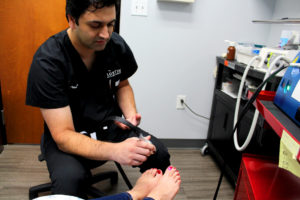Podiatrists in Austin
Are you looking for a foot & ankle doctor in the Austin, TX area? Then you’ve come to the right place!
We serve the Austin metro community and are dedicated to providing high-quality foot and ankle care. Our qualified podiatric physicians (foot doctors) specialize in foot ailments, including foot pain, foot injuries, diabetic foot ulcers, hammertoe surgery, and bunion correction surgery.
 Here’s something you’ve probably never heard before. Your feet are more than just the foundations you stand on. They are foundations for your overall health. Many common and not-so-common health concerns begin with your feet. The problem is that most doctors don’t think to look at your feet first for signs of trouble.
Here’s something you’ve probably never heard before. Your feet are more than just the foundations you stand on. They are foundations for your overall health. Many common and not-so-common health concerns begin with your feet. The problem is that most doctors don’t think to look at your feet first for signs of trouble.
At Austin Podiatry Centers, our foot specialists always look at your feet first. Even if you complain about a problem seemingly having little or no bearing on your feet. Like back pain, shoulder pain, or fibromyalgia. What makes us different is that we look at the whole body – the whole person – to find the cause of the pain or illness.
Our patients feel like whole human beings who are always well cared for, even pampered, when they visit. And they know they can come to us for so much more than foot problems. That’s because we are so much more than a podiatry practice.
Austin Foot & Ankle Specialists
We offer treatment for bunions, hammertoes, diabetic foot ulcers, heel pain, toenail fungus, toe problems, foot injuries, ankle pain, foot hyper perspiration, foot sensitivity, foot deformities, foot mal-alignment, foot odor, and fungus infection of the feet. Foot and Ankle Surgery can, in many cases, be performed at a same-day outpatient surgical center setting, requiring no hospitalization. Our podiatrist office accepts most insurances, including Medicare, and we have convenient evening and Saturday appointments available.
When should you see an Austin Podiatrist / Foot Doctor?
Sometimes, your first inclination is to ignore foot or ankle pain, hoping it will go away independently. However, how do you know when to call a podiatrist? Check out the following information for tips on when your pain is serious enough to warrant a call to the doctor.
- If you notice changes on your feet, such as cracked or peeling skin, blisters, or other noticeable changes to your skin or nails, it’s time to call the podiatrist for an evaluation. Additionally, persistent pain that does not decrease after two weeks means your foot doctor should check you out.
- Bacterial infections of cuts or cracks on the foot are serious, especially in people who also suffer from diabetes. These infections require treatment by a podiatrist and can cause several symptoms, including red streaks on the skin of your foot, discharge of pus from cuts or cracks, pain, swelling, sensitivity to cold or heat, a fever of 100 degrees or higher that has no other obvious cause, or a noticeable spread of infection to surrounding skin or other areas of the foot, including toenails.
- Heel pain, in particular, should be evaluated by a podiatrist, especially if it occurs along with a fever, warmth, or swelling of the foot and sensations of numbness or tingling in the heel. If you experience heel pain that cannot be reduced by over-the-counter medications, ice, or elevation, schedule an appointment with your foot doctor as soon as possible.

In addition to the common reasons to visit a podiatrist, here are some issues that could point to a serious issue:
- You have noticeable changes to your nails or skin.
- Your feet are severely cracking, scaling, or peeling.
- There are blisters on your feet.
- There are signs of bacterial infection, including:
- Increased pain, swelling, redness, tenderness, or heat.
- Red streaks extend from the affected area.
- Discharge of pus.
- Fever of 100°F(37.78°C) or higher with no other cause.
- Symptoms that do not improve after two weeks of treatment with a non-prescription product.
- The infection can spread to other areas, such as the nail bed or skin under the nail, the nail itself, or the surrounding skin.
- Your toenail is getting thicker and causing you discomfort.
- You have heel pain accompanied by a fever, redness (sometimes warmth), numbness, or tingling in your heel, persistent pain without putting any weight or pressure on your heel, or pain that is not alleviated by ice or aspirin (ibuprofen or acetaminophen).
- You have diabetes or certain diseases associated with poor circulation, and you develop athlete`s foot. People with diabetes are at increased risk for a severe bacterial infection of the foot and leg if they have an athlete’s foot.
Why Choose Austin Podiatry
Here are five reasons why you should choose us:
- We are driven to give every patient the healthiest and best-looking feet possible.
- We have delivered complete foot care solutions to patients for almost ten years, and our patients continue to recommend us to their friends.
- Every week, we work to stay current on all new developments in podiatry. Our goal? To provide you with the most technologically advanced foot care available today.
- We’re dedicated to making your foot care experience the best possible.
- We treat you like family.
Foot Problem Facts
- 1/4 of all the bones in the human body ARE IN YOUR FEET. If they are out of alignment, so is the rest of your body.
- 3 out of 4 Americans experience serious foot problems in their lifetime.
- The foot contains 26 bones, 33 joints, 107 ligaments, and 19 muscles.
- Only a small percentage of the population is born with foot problems.
Neglect and a lack of awareness of proper care – including ill-fitting shoes – bring on problems. - Women have about four times as many foot problems as men. High heels are partly to blame.
- Arthritis is the number one cause of disability in America. It limits everyday dressing, climbing stairs, getting in and out of bed, or walking – for about 7 million Americans.
- There are 250,000 sweat glands in a pair of feet. Sweat glands in the feet excrete as much as a half-pint of moisture daily.
- The two feet may be different sizes. Buy shoes for the larger one.
Quality Care
When you have problems with your feet, you need to turn to a podiatrist who listens and responds … an experienced doctor who knows the field and can effectively diagnose and treat your needs … a friendly physician who counsels you on the best ways to maintain and improve your health. Our staff meets all these criteria. You benefit from doctors with more than 40 years of experience in podiatric medicine who can give you individualized attention.
Informed Patients
Austin Podiatry Centers believes that informed patients are better prepared to make decisions regarding their health and well-being. That is why we’ve included an extensive section on this website covering the topics associated with podiatry and podiatric diagnoses and treatments. We encourage you to look through these pages whenever you are interested or concerned about your feet.
Comfortable, Convenient Setting
The best care in the world doesn’t mean anything if you can’t access it. At Austin Podiatry Centers, we strive to make our Austin, TX, office as efficient and convenient as possible. These web pages include information about our office, including our Round Rock and Austin locations, maps, directions, hours, insurance policies, and appointment scheduling.
We hope you find this website useful and invite you to contact us with any questions.
FAQ: Understanding Austin Podiatry
What is the difference between a foot doctor and a podiatrist?
The term “foot doctor” is a general and informal term that refers to any healthcare professional who specializes in treating feet, including podiatrists. A podiatrist is a specialized medical professional trained in caring for the foot, ankle, and related structures of the leg.
What is the new name for podiatrist?
The term “podiatrist” remains the standard professional designation. In some regions, podiatrists are called “Doctor of Podiatric Medicine” (DPM), emphasizing their specialized medical training in podiatry.
Why is podiatry not part of medical school?
Podiatry is a specialized field with its own specific medical and surgical training programs, which are separate from general medical school. Podiatrists attend podiatric medical colleges where they receive extensive training in the anatomy, pathology, and treatment of the foot and ankle, distinct from the broader focus of medical schools.
Is a podiatrist a physician in Texas?
In Texas, podiatrists are considered physicians concerning their specialty. They are licensed to diagnose and treat conditions of the foot, ankle, and related structures, and they can perform surgery, prescribe medications, and use the title “Doctor” as they hold a Doctor of Podiatric Medicine (DPM) degree.
Is it better to go to a podiatrist or orthopedist?
Whether to visit a podiatrist or an orthopedist can depend on the specific condition of your feet or ankles. Podiatrists specialize exclusively in the foot and ankle and are well-equipped to handle most related conditions. Orthopedists cover a broader range of musculoskeletal issues, including the feet, but their scope is wider. A podiatrist is typically the best choice for foot-specific issues, while more complex cases involving multiple bodily systems may benefit from an orthopedic surgeon.
What is the most common problem treated by a podiatrist?
The most common problems podiatrists treat include plantar fasciitis, bunions, ingrown toenails, fungal infections, and diabetic foot care. They also frequently treat sports injuries and other trauma-related foot issues.
What is higher than a podiatrist?
In terms of medical hierarchy, podiatrists are specialists in their field and do not have a “higher” rank within podiatry itself. In multidisciplinary teams, they work alongside other medical professionals, each expert in their own area.
Why do podiatrists make so much money?
Podiatrists often earn a significant income due to their specialized skills and high demand for foot and ankle care. Their ability to perform surgery, treat chronic conditions, and offer specialized care that can prevent more serious health issues adds to their value in the healthcare system.
Should you let a podiatrist do surgery?
Yes, qualified podiatrists are trained to perform foot and ankle surgeries. They undergo extensive surgical training during their education and residency, handling everything from minor procedures to complex reconstructions. A podiatrist is typically well-qualified to perform such procedures if a surgical solution is recommended for a foot or ankle problem.


